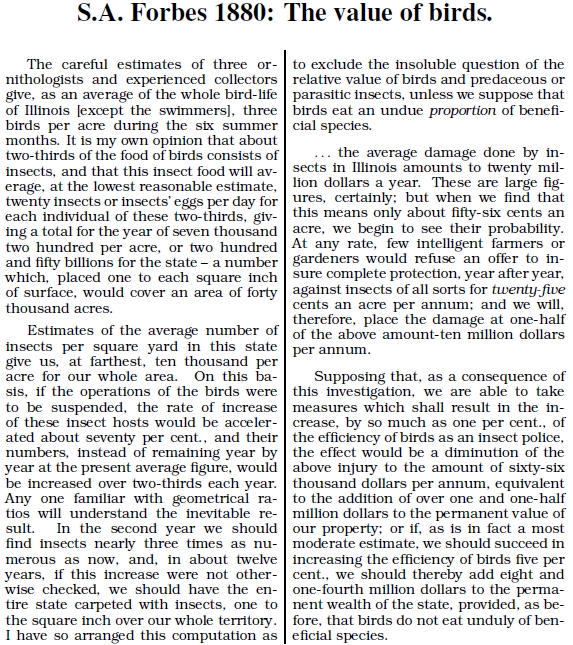5. 2 Bird Values
Figure 5.2: Excerpt of Illinois naturalist Stephen Forbes’s (1880) article that likely makes the first “ecosystem services” calculation concerning the monetary value of birds’ insect control. Essentially, he stated that birds eat lots of insects that incur monetary damage, and promoting more birds reduces that damage in a cost-effective manner.
Valuation concepts have recently turned to the idea of “ecosystem services.”[5] As shown in Figure 5.2, within a naturalist’s massive 1880 article on the things birds eat, Stephen Forbes makes what might be the first ecosystem service calculation. He assumed that there were three birds per acre in Illinois during the six months of the growing season, that each bird eats, at minimum, 20 insects per day, or 7,200 insects eaten per acre per year, while citing birds that eat 10 times more than that number. He then argues that estimates for insect densities are 10,000 per acre and that the loss of the birds would increase insect densities by 70%, which, he said, ignores the fact that the birds don’t distinguish insects that humans consider beneficial. He then asks what benefit would result if we could increase the efficiency of birds by 1% (by increasing their population), or their marginal benefit at that density, and he comes up with the number of $66,000 (in 1880 dollars) per year for the state of Illinois.
Updating these numbers a bit, but likely not their accuracy, we find that insecticide costs in Georgia in 2003 ranged from $4.50 to $60.00 per acre per year, excluding application costs.[6] At the same time, Georgia public health costs related to insects[7] —everything from doctors’ fees for head lice to the cost of flyswatters— are set at over $209 million. Total dollar losses, including both control and damage, for the state of Georgia were estimated at more than $680 million, with mosquitos taking the number one spot at a cost of $122 million. Georgia’s nearly 58,000 square miles, or 37 million acres, implies an average damage of $18 per acre (compared with Forbes’s 56 cents damage per acre in 1880 dollars for Illinois).[8] Following Forbes’s logic and 70% number, the benefit of birds in Georgia might be about $10 per acre in terms of insect control, both preventing damage and reducing treatment costs. This calculation means that regulations or programs that increased Georgia’s bird populations by 50% could be valued as providing a benefit of, perhaps, $5 per acre, or $185 million to the state on an annual basis. Not a shabby number.
If similar numbers for damage held true for North Carolina’s 31 million acres, an increased bird population would provide a $155 million statewide benefit, and for Durham County’s 186,000 acres, a nearly $1 million annual benefit. How much is $155 million worth these days? In a sobering comparison, total retail sales in North Carolina during the month of February 2007 were $9 billion, with over $310 million collected on that amount in taxes, according to the North Carolina Department of Revenue. Increasing statewide bird populations by 50% equals collecting half-a-month’s sales tax.
——————————
[5]An excellent review of ecosystem services and valuation was done by Farber et al. (2006).
[6]Guillebeau et al. (2006) report insecticide costs and benefits in Georgia.
[7]Spider bites were also included within the Georgia public health publication (Guillebeau et al. 2006) on insect costs; let’s not be pedantic over the term insects.
[8]I found a Web-based utility, apparently run by academics, that compares currency values across large spans of time at www.measuringworth.com. It shows that $0.56 from 1880 had the following values in 2003: $10.40 using the Consumer Price Index; $9.77 using the GDP deflator; $72.62 using the unskilled wage; $102.33 using the nominal GDP per capita; and $592.38 using the relative share of GDP. I take that to mean my calculation of $18 per acre for the damage done by insects, and $10 per acre for the value of birds’ “ecosystem service,” is comparable to Forbes’s values.
